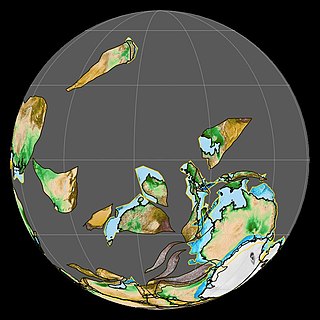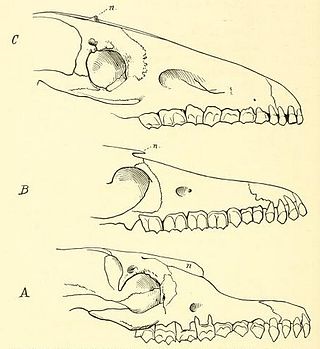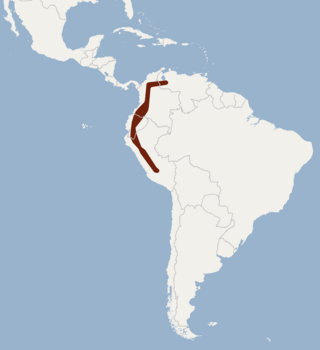
Anacondas or water boas are a group of large boas of the genus Eunectes. They are a semiaquatic group of snakes found in tropical South America. Three to five extant and one extinct species are currently recognized, including one of the largest snakes in the world, E. murinus, the green anaconda.

The Appalachian Mountains, often called the Appalachians, are a mountain range in eastern to northeastern North America. The term "Appalachian" refers to several different regions associated with the mountain range, and its surrounding terrain. The general definition used is one followed by the United States Geological Survey and the Geological Survey of Canada to describe the respective countries' physiographic regions. The U.S. uses the term Appalachian Highlands and Canada uses the term Appalachian Uplands; the Appalachian Mountains are not synonymous with the Appalachian Plateau, which is one of the provinces of the Appalachian Highlands.

Chelidae is one of three living families of the turtle suborder Pleurodira, and are commonly called Austro-South American side-neck turtles. The family is distributed in Australia, New Guinea, parts of Indonesia, and throughout most of South America. It is a large family of turtles with a significant fossil history dating back to the Cretaceous. The family is entirely Gondwanan in origin, with no members found outside Gondwana, either in the present day or as a fossil.

Podocnemididae is a family of pleurodire (side-necked) turtles, once widely distributed. Most of its 41 genera and 57 species are now extinct. Seven of its eight surviving species are native to South America: the genus Peltocephalus, with two species, only one of which is extant ; and the genus Podocnemis, with six living species of South American side-necked river turtles and four extinct. There is also one genus native to Madagascar: Erymnochelys, the Madagascan big-headed turtle, whose single species E. madagascariensis.

Trinidad is the larger and more populous of the two major islands of Trinidad and Tobago. The island lies 11 km (6.8 mi) off the northeastern coast of Venezuela and sits on the continental shelf of South America. It is often referred to as the southernmost island in the West Indies. With an area of 4,768 km2 (1,841 sq mi), it is also the fifth largest in the West Indies.

Nothofagus, also known as the southern beeches, is a genus of 43 species of trees and shrubs native to the Southern Hemisphere in southern South America and east and southeast Australia, New Zealand, New Guinea, and New Caledonia. The species are ecological dominants in many temperate forests in these regions. Some species are reportedly naturalised in Germany and Great Britain. The genus has a rich fossil record of leaves, cupules, and pollen, with fossils extending into the late Cretaceous period and occurring in Australia, New Zealand, Antarctica, and South America.

Hevea brasiliensis, the Pará rubber tree, sharinga tree, seringueira, or most commonly, rubber tree or rubber plant, is a flowering plant belonging to the spurge family Euphorbiaceae originally native to the Amazon basin, but is now pantropical in distribution due to introductions. It is the most economically important member of the genus Hevea because the milky latex extracted from the tree is the primary source of natural rubber.

The moriche oriole is a passerine bird in the New World family Icteridae. It is unrelated to Old World orioles. It is a breeding resident in the tropics of eastern South America. This bird is noted for its close association with the palm Mauritia flexuosa.

The genus Bassaricyon consists of small Neotropical procyonids, popularly known as olingos, cousins of the raccoon. They are native to the rainforests of Central and South America from Nicaragua to Peru. They are arboreal and nocturnal, and live at elevations from sea level to 2,750 m (9,020 ft). Olingos closely resemble another procyonid, the kinkajou, in morphology and habits, though they lack prehensile tails and extrudable tongues, have more extended muzzles, and possess anal scent glands. However, the two genera are not sisters. They also resemble galagos and certain lemurs.

The Tournaisian is in the ICS geologic timescale the lowest stage or oldest age of the Mississippian, the oldest subsystem of the Carboniferous. The Tournaisian age lasted from 358.9 Ma to 346.7 Ma. It is preceded by the Famennian and is followed by the Viséan. In global stratigraphy, the Tournaisian contains two substages: the Hastarian and Ivorian. These two substages were originally designated as European regional stages.

The South American gray fox, also known as the Patagonian fox, the chilla or the gray zorro, is a species of Lycalopex, the "false" foxes. It is endemic to the southern part of South America.

Ulmus alata, the winged elm or wahoo, is a small- to medium-sized deciduous tree endemic to the woodlands of the southeastern and south-central United States. The species is tolerant of a wide range of soils, and of ponding, but is the least shade-tolerant of the North American elms. Its growth rate is often very slow, the trunk increasing in diameter by less than 5 mm per year. The tree is occasionally considered a nuisance as it readily invades old fields, forest clearings, and rangelands, proving particularly difficult to eradicate with herbicides.

Oligoryzomys flavescens, also known as the flavescent colilargo or yellow pygmy rice rat is a species of rodent in the genus Oligoryzomys of family Cricetidae. It is found in southern South America, occurring in southern Brazil, Paraguay, Uruguay, and northeastern Argentina. Its karyotype has 2n = 64-66 and FNa = 66–70.

Scalabrinitherium is an extinct genus of mammals of the family Macraucheniidae. Fossils of this animal were found among the fossils of prehistoric xenarthrans in the Ituzaingó Formation of Argentina.

The bidentate yellow-shouldered bat is a species of bat in the family Phyllostomidae. It is found in South America.

The Bogotá yellow-shouldered bat is a species of bat in the family Phyllostomidae. It is found in Colombia, Ecuador, Peru, and Venezuela at altitudes from 300 m to above 2000 m, particularly in cloud forest. The species is primarily frugivorous; it may also consume nectar and pollen.

Freshwater snails are gastropod mollusks that live in fresh water. There are many different families. They are found throughout the world in various habitats, ranging from ephemeral pools to the largest lakes, and from small seeps and springs to major rivers. The great majority of freshwater gastropods have a shell, with very few exceptions. Some groups of snails that live in freshwater respire using gills, whereas other groups need to reach the surface to breathe air. In addition, some are amphibious and have both gills and a lung. Most feed on algae, but many are detritivores and some are filter feeders.

Thomas's big-eared brown bat is a species of vesper bat found in South America.
Myotis diminutus is a species of mouse-eared bat found in Ecuador and Colombia. It was recently described as a new species in 2011.

Sturnira bakeri is a species of bat found in South-America.


















